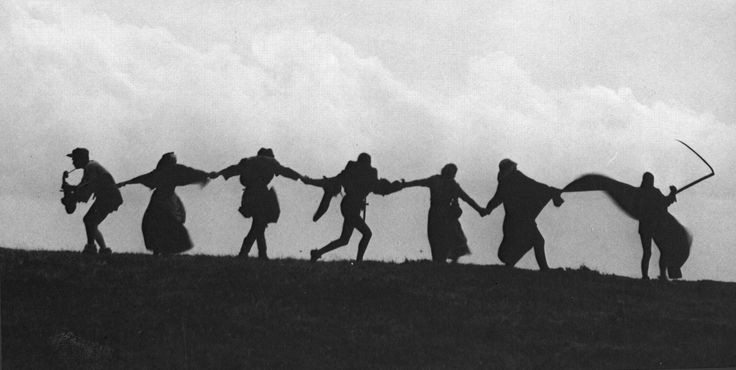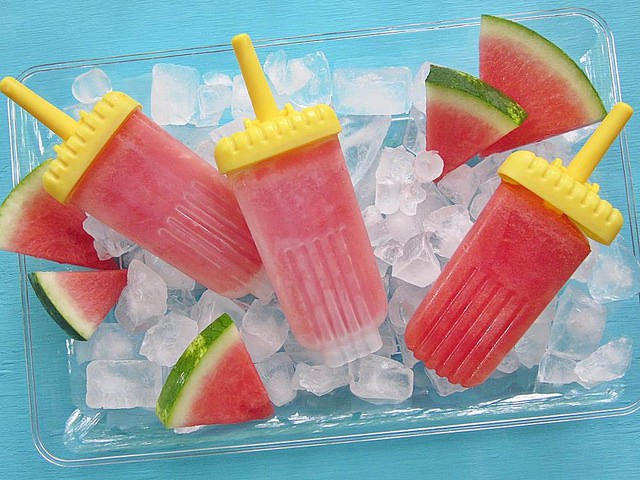Snacks Discussed
Mary HK Choi, this publication’s former snack critic, has a new snack-focused content-type thing, and you can read more about it here. I will tell you that while six-and-a-half minutes usually seems like an interminable amount of time for a web video production, this somehow flies by and suddenly the whole thing is over and you’re wondering what just happened. You will probably enjoy it a lot more if you don’t stop to think about the fact that, because it’s on the Internet, there is probably someone jacking off to it somewhere right now. Anyway, it’s great and I can’t wait for more episodes. Please share with everyone you know who appreciates snacks and snack-centered discourse.
New York City, July 13, 2015

★★★ Extra humidity rose from the hosed-down sidewalk. A white moped sped along to cut off an otherwise clear jaywalking experience. The coffee kicked in as the sky opened into relative expansiveness where Broadway hit Columbus Circle, and the voice of Mahalia Jackson sang “Great Gettin’ Up Morning” in the skull. A tall figure on rollerblades roared by on the sidewalk, less deftly than something of that speed ought to have, cutting a palpable wake. At the office, on the fire escape, there was cool air for the ankles and enough battery to stay out there in the shade. The sun was hot and direct; the eight-year-old’s hand chilly as he came out of the air conditioned day camp. The water in the fountain by the forecourt was algal green, with a foam on it. The smell of burning charcoal carried on the evening air.
How Your Jizz Is Expressed
“In my mind, it is always ‘coming,’ ‘come,’ or ‘came,’ respectively, because I find the shorthand to be one of the worst slang terms available in the English language. It’s so…truncated. It’s squat. ‘Cum’ is for the men trying to get me to cyber with them on ICQ; it’s the paperbacks I found in the bookcase of a rental apartment my family once lived in. ‘Cum’ is the deliberately misspelled phrase that, to me, fails to denote any kind of sexually satisfying sleaze and instead only conjures up grease, a shortcut to pleasure, and there are no shortcuts to pleasure, or at least there shouldn’t be.”
— How do you spell that stuff?
Yo La Tengo, "Friday I'm In Love"
This cover of the Cure classic is very pretty and the story that the video tells is even prettier. The whole thing is like some beautiful dream.
The Internet Shows That You're Just Like Everyone Else

“Then came the Internet. In all of human history, there’s never been so much access to the relatively raw content of other minds. They mostly turn out to be as limited as our own.”
— I was chatting recently with someone I met over a decade ago during the short period of the Internet when it seemed as if the burgeoning currency of the community would create a new congregation of like-minded individuals who up until that moment had been prevented from truly discovering their tribes, and that this congress would be, on the whole, a good thing. We spoke briefly about that golden era in our memory before I expressed dismay about the current condition of the culture, to which he responded, “Oh, the Internet. Through some quirk it initially obscured, to an extent, just how horrible our species is, but now it is a very polished and perfect mirror,” and between that estimation and the assessment you find above it seems as if we have come upon the most fair and accurate representation of what we’re left with, web-wise, that I know of.
Now, yes, Balk’s Law, the one declaring that “Everything you hate about The Internet is actually everything you hate about people,” and Balk’s Second Law (“The worst thing is knowing what everyone thinks about anything”) indicate I should not in any way have been surprised by this degeneration, but Balk’s Third Law — “If you think The Internet is terrible now, just wait a while” — goes a long way toward excusing my naiveté; things really were much better back then. And they’ll be so much more awful than they are right now, as difficult as that may be to believe. If you’re looking for an optimistic note at the end of this observation I am sorry to say that you will not find one; at the outset I had a brief bit of optimism to offer but the sheer act of getting this all down made me realize just how hopeless it all is for us. Everything is terrible and only getting worse, and that indisputable assertion somewhat downplays just how bad things really are at present. The best I can do is remind you that everything ends, which will have to be enough for now. I’m not happy about it either.
Freeze the Watermelon

Watermelons appear in grocery stores and in giant cardboard boxes outside markets at about the same time of the year that people start wearing shorts, but range in flavor from lousy to barely okay until around July 4th. The best way to eat watermelon is to cut it into cubes and eat the entire thing in one sitting, but that’s not really much of a recipe and I have column inches to fill here. The second-best way isn’t a watermelon gazpacho, or a watermelon-feta salad, or even simple salted watermelon, delicious as all of those preparations are. No, the second-best way to eat watermelon, especially during the sweat-soaked summer months, is to freeze it. What could be better than eating watermelon in the summer? How about eating extremely cold watermelon in the summer?
Watermelon is technically a type of berry called a pepo. The word berry, in general, refers to any fruit that emerges from a single flower, and includes a wide variety of edible items we refer to sometimes as fruits and sometimes as vegetables. The tomato is a berry, as is the avocado, the zucchini, and the persimmon. What classifies a particular berry as a pepo is basically that it has a very hard rind — restricting the term, mostly, to melons and gourds.
The watermelon is a very old fruit, originating somewhere in southern Africa, and there are hundreds, probably thousands, of different varieties. It is very frustrating that in most of the U.S., watermelons are advertised simply as “watermelons,” and not by their specific variety, because the variety can tell you a lot about color, texture, ripeness, flavor, and sugar content. Some watermelons are sweeter, some more watery, some stronger or lighter in flavor. Some have seeds and some do not. Some are yellow or orange or white on the inside. Some are spherical or ovoid or green or black or speckled or striped or mottled on the outside. Some ripen early, in late June, and some aren’t at their peak until August.
Because we have so little information about our watermelons, it can be tricky to pick one out. There are lots of tricks; my dad always liked to sniff the part of the melon where the stem was attached. I never quite figured out what he was looking for. Some people slap the melon to test for its acoustics. This is a very fun way to test for ripe fruit, and I would never discourage someone from slapping a melon. Slap it! Haha. But I rely on a simpler method: Heft many melons in your hands, and pick the one that feels heaviest for its size. More weight equals more sugar, which is what we want.
In general, I prefer the smaller, spherical melons over the giant ovoid ones. In New York, many small, spherical watermelons are of the Sugar Baby variety, which has an extremely high sugar content and a nice, crisp, rarely mealy flesh. But I highly encourage you to grab any weird melons you see; the Moon and Stars watermelon, for example, which has a nearly black rind speckled with some pale yellow spots and one or two large yellow patches, is almost always excellent. I’ll also never turn down a melon of unexpected color, like the Yellow Baby or Saskatchewan, though they can be tough to find.
Cutting a melon isn’t any different from cutting anything else. With a chef’s knife (there’s no need for a serrated knife here), slice the melon in half, then in half again. Cut into triangle-shaped wedges, then trim off the rind and discard (or pickle, if you like). Chop into cubes, and try not to eat them all, because there’s more to be done with this melon. Maybe you should have an eating melon alongside when preparing these frozen melon treats.
If you’ve got a seedless watermelon, toss the cubes into a blender or food processor and blend thoroughly. If there are black seeds, you’ll have to take them out first; this is a pain, though at least you’ll have a bunch of watermelon to console you. Then pour the blended watermelon into a fine strainer. You can use a colander lined with cheesecloth, but I prefer a simple fine mesh strainer like this one. You’ll have to use your palm to smush the melon pulp against the strainer to get all the juice out, but it’s worth it.
Once you’ve got your watermelon juice, you’re prepared to do all kinds of fun cold stuff with it. There are ways to make popsicles without dedicated popsicle molds; you can simply freeze your popsicle in a paper cup and stick a popsicle stick in there. But popsicle molds cost like twelve dollars and will do a better job. The Sweethome recommends this silicone one, which seems nice; I have these plastic ones, some of which have cracked over the years, so maybe silicone is the way to go.
The secret to a good popsicle is much like the secret to a good soup: You need much more seasoning than you think you do. You may think, damn, thanks to Dan’s very good advice for picking out a watermelon I have an extremely sweet watermelon here, so I probably don’t need much sugar for these pops. You’d be wrong. Pops always need more sugar than you’d think, and usually some salt as well.
As for flavoring, do not include whole leaves of herbs in a popsicle. Jesus Christ. Have you ever enjoyed gnawing on a half-exposed floppy leaf of basil in a popsicle? Nobody has. The best way to get herb flavor into your pop is with a flavored simple syrup. In a saucepan on the stove, combine a cup of white sugar, half a cup of water, and a few big healthy sprigs of either basil or mint, and stir over medium heat until the sugar is all dissolved. Let it cool down to room temperature with the leaves still sitting in there, then remove and discard the leaves.
Watermelon-Basil Popsicle
Shopping list: Watermelon, limes, basil simple syrup, salt
Combine watermelon juice with simple syrup until it tastes just a touch too sweet. This depends on the sweetness of your melon but one tablespoon of simple syrup to one cup of juice is a good place to start. Add a squeeze of lime and a pinch of salt, stir to combine, pour into molds and stick in the freezer overnight.

A very underrated and delicious texture is that of very small ice shards just on the verge of melting. In southeastern Pennsylvania, where I grew up, this is called “water ice,” a perfect name because, ideally, a good water ice should be hovering delicately on the thin line between liquid and solid. In New York and elsewhere, there is a garbage version known as “Italian ice,” which is like “dairy-free ice cream” or “high-fructose corn syrup sorbet.” It is scooped into a paper cup and retains the shape of the scoop, which means, according to second grade science, that it is a solid, and thus solidly bullshit. Just get an ice cream if that’s what you want.
Anyway it is pretty easy to make a home version of water ice, and watermelon juice, being abundant and less viscous than many other fruit juices, is ideal. The whole game is to sneakily tiptoe down to the freezing point of your juice, then serve right as the concoction isn’t sure whether it’s frozen or liquid. One technique for this is to freeze the juice fully, then let it thaw slightly, then break up the ice crystals before serving. The best way to move your frozen juice to the fridge, which will very very slowly defrost it, for an hour or two, then drag a good strong fork through it. Another way is to carefully watch the mixture as it freezes, checking every hour and dragging, with a fork, the ice crystals that form along the edge of the container into the still-liquid middle.
Either method will create a texture very close to southeast Pennsylvania water ice, though if you want to impress people who aren’t impressed by your knowledge of Philly cuisine you can call it a granita. “Granita” is Italian for “water ice.”
But my preferred method is easier, and more fun. Just use booze!
Alcohol’s freezing point is much, much lower than water’s, so you can sneakily mess with the freezing point of your water ice/granita/slush by adding a little bit of alcohol to the mixture. That way you can skip the whole transferring to the fridge business, because your water ice will never quite freeze. Don’t add too much alcohol to the mix, or you’ll never get any ice crystals at all; remember, you can always add more after, so keep the ratio to about one part liquor to 10 parts non-liquor. Basically any cocktail can be turned into a watermelon water ice; watermelon has an affinity for gin, vodka, tequila, and even, in certain applications, according to some websites, bourbon. My favorite is gin.
Watermelon GIN-ger Water Ice
Shopping list: Watermelon, fresh ginger, limes, gin, white sugar, fresh mint
First, make a ginger simple syrup. In a saucepan, simmer two cups of water, one cup of white sugar, and two thumb-size knobs of ginger (sliced thinly into rounds) for about 20 minutes. Strain out ginger and any weird particles.
In a large glass casserole, mix five cups watermelon juice, a quarter cup of gin, a quarter cup of ginger syrup, a pinch of salt, and a squeeze of lime. Taste: it should taste like a good but too-sweet cocktail. Place in freezer for at least three hours, overnight if you want. Before serving, drag a fork through the granita to break it up into small bits of ice. Chop mint thinly; a chiffonade would be nice and annoying. Serve in bowls or cups and top with mint.

These are just a few to get you started. Watermelon is a fairly neutral fruit, mostly just watery, sugary, and slightly vegetal, so it goes with pretty much any flavor. It takes well to salt, to spice, and to acid. I’ve had good luck with frozen treats made from watermelon juice mixed with everything from sherry vinegar to tomato puree to Pimm’s to cayenne. In fact due to its high water content there’s very little you can’t do with it; some people like to freeze the juice in an ice cube tray to flavor drinks. Some people like to freeze the actual cubes of raw cut melon and blend them in high-powered blenders (which I cannot afford) to make an icy smoothie. It’s hard to mess up when the fruit — sorry, pepo — wants so badly for you to freeze it.
Photo by Jennifer Chait
Insomniacs Get More Sleep Than They Think But Never Shut The Fuck Up About How Tired They Are
“It turns out that many people are terrible judges of how much shut-eye they get. That is especially true for those who have insomnia. Many people with insomnia think they sleep much less than they actually do. They tend to misjudge how long it takes for them to fall asleep and how often they wake up during the night. Sometimes people can even mistake being asleep for being awake.”
Privilege Checked

“First Words,” the New York Times Magazine’s weekly language column, may be its best recurring front-of-book feature. This week, Parul Sehgal considers “privilege.” Crucially, she hits on how, as “the shine has come off this hardy, once-helpful word,” it has, through no fault of its own, become the single most effective derailing tool in online discourse over the last couple of years:
“Privilege saturates” — and privilege stains. Which might explain why this word pricks and “opportunity” and “advantage” don’t. “I can choose to not act racist, but I can’t choose to not be privileged,” a friend once told me with alarm. Most of us already occupy some kind of visible social identity, but for those who have imagined themselves to be free agents, the notion of possessing privilege calls them back to their bodies in a way that feels new and unpleasant. It conflicts with a number of cherished American ideals of self-invention and self-reliance, meritocracy and quick fixes — and lends itself to no obvious action, which is perhaps why the ritual of “confessing” to your privilege, or getting someone else to, has accumulated the meaning it has. It’s the fumbling hope that acknowledging privilege could offer some temporary absolution for having it.
There is, of course, little hope for any of us to absolve ourselves of privilege, or any other sin, really, beyond lying down and dying.
Photo by Shinya Suzuki
All Dogs, "That Kind Of Girl"
In ten thousand years, when man has destroyed itself either directly or through Earth, the only remaining evidence that we ever existed will be a few scorched fossils and a vibrant and ongoing alt revival.
Enjoyment Rationalized

“I tend to gravitate toward a genre of popular culture I’ve come to think of as emotional speculative fiction. It’s a close cousin of science fiction: The central narrative bears a plausible relation to our lived reality, but everything is heightened, for better or worse. In science fiction, our experiences are filtered through the fantastical — an alien virus arrives from outer space and decimates a marginalized population, perhaps, or there’s a power-hungry dictator hellbent on world domination in a universe far, far away. Emotional speculative fiction takes place closer to home but is no less fantastical,” says a woman trying to justify her appreciation of “Gilmore Girls.”
